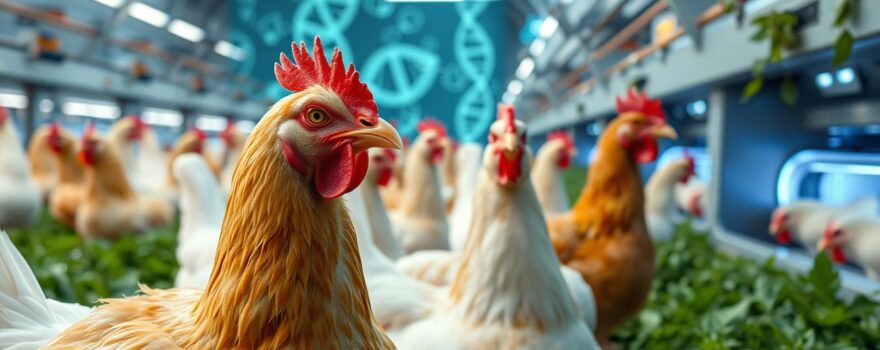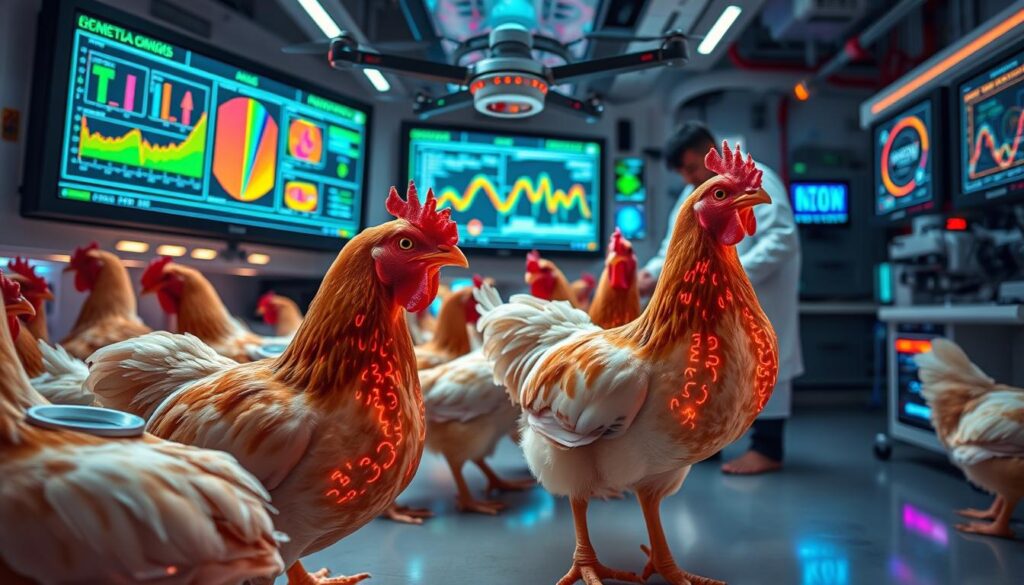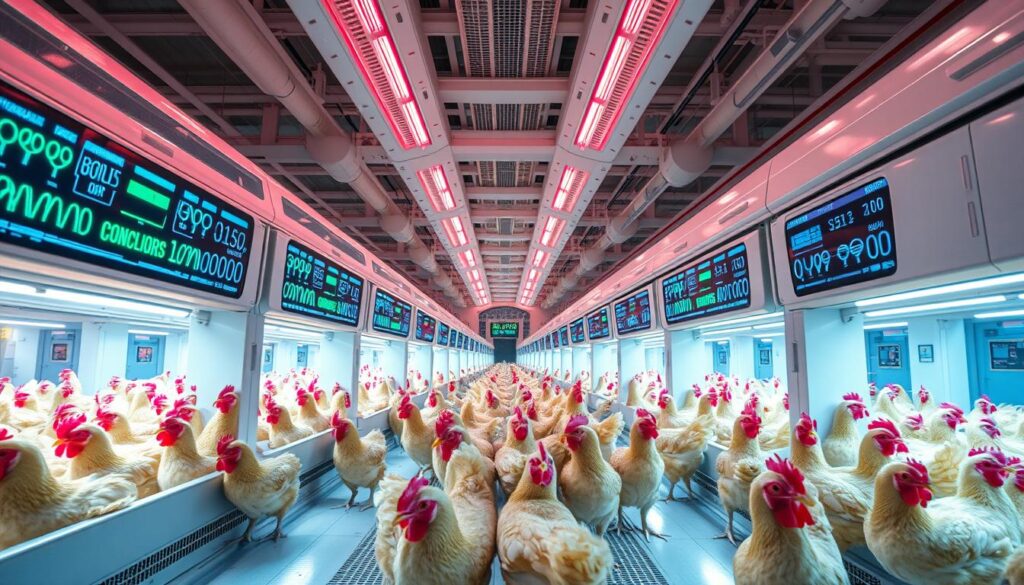
The poultry breeding industry is on the verge of a big change. Broiler companies are growing their breeding programs to include more traits. They aim to meet changing consumer needs for healthier, more sustainable chicken products.
In the last 30 years, breeding goals have grown a lot. Now, they focus on traits like productivity, health, and welfare. To make the most of these traits, the industry needs to keep investing in research and development.
New technologies are also changing the game. Advanced imaging, monitoring feed efficiency, and genomics are key. Otto’s Farms is leading the way, using these tools for better, more sustainable chicken farming.
Gene editing is exciting, but it’s limited in Europe due to GMO rules. So, experts don’t see it becoming common in chicken breeding soon. Instead, they’re focusing on improving traditional breeding and using new tech to unlock chicken genetics.
The Transformative Potential of Digital Phenotyping
Digital phenotyping is a new way to measure animal traits in real-time using digital devices. It’s changing the broiler industry in big ways. It helps solve problems like improving productivity, animal care, and reducing environmental harm. This is done by closely watching and managing each bird.
Digital phenotyping is linked to Precision Livestock Farming (PLF). PLF uses new tech to make farming more efficient and green. It collects detailed data on animal health and performance. This helps farmers make better choices and run their farms better.
| Key Benefit | Impact |
|---|---|
| Enhanced Productivity | Digital phenotyping can help identify and address factors that limit broiler growth and feed conversion, leading to increased yields and profitability. |
| Improved Animal Welfare | Real-time monitoring of individual bird behavior and health status can enable early intervention and proactive measures to ensure optimal animal welfare. |
| Reduced Environmental Impact | By optimizing feed efficiency and minimizing waste, digital phenotyping can contribute to a more sustainable broiler industry with a lower carbon footprint. |
The broiler industry is growing, and digital phenotyping is leading the way. It’s opening doors to better productivity, animal care, and environmental protection. This technology is shaping the future of the industry.
Digital Twins: Revolutionizing Broiler Genomics
Digital twins are exact digital copies of real things. They are changing broiler genomics a lot. By making digital copies of broiler chickens, scientists can speed up genomic research and use it in real life.
Digital twins let scientists study genetics without physical tests. This means they can learn about good traits in broilers faster. This new way of doing broiler genomics research is a big change.
Accelerating Genomic Research through Digital Replication
Digital twins help scientists in broiler genomics research a lot. They can try out genetic ideas without the cost and time of real tests. This digital way helps them understand how genes affect traits better and faster.
With digital twins, scientists can test ideas quickly. They can try different genetic changes and see how they affect broiler traits. This makes genomic research faster, so they can use new findings in broiler farms sooner.
“The integration of digital twins with broiler genomics research is a game-changer, unlocking unprecedented opportunities for innovation and progress in the poultry industry.”
The future of the poultry industry looks bright with digital twins and broiler genomics. Together, they will lead to better broilers in many ways. This includes better growth, health, and how they use resources.
Advances in Broiler Chicken Genetics: What to Expect in the Future
The poultry industry is changing fast. Experts say we’ll see broiler breeding focus on more than just growth. It will also look at liveability, robustness, and welfare. Breeders will need to invest in research to understand new traits and meet consumer demands.
New tech like 3D imaging and genomics will help pick the best birds. This will lead to better feed efficiency and meat quality. Broilers will also be able to handle different environments better.
Industry data shows a big jump in productivity thanks to precision farming. Automated feeding robots cut down on waste and improve efficiency. Cleaning robots also help keep farms clean, reducing disease and death rates.
| Metric | Improvement |
|---|---|
| Productivity | 20% increase |
| Feed Wastage | 15% reduction |
| Feed Conversion Ratio | 10% improvement |
| Mortality Rates | 30% decrease |
Monitoring robots help reduce environmental impact by 25%. Robotics and automation cut labor costs by 35% and boost efficiency by 40%. They also lower antibiotic use by 20% by catching diseases early.
These changes in broiler genetics, productivity, and sustainable production will shape the future. They will meet the growing demand for poultry products.
Genomic Selection: Unlocking Genetic Potential
In the world of broiler chicken breeding, genomics is changing the game. It helps unlock the genetic potential of flocks. Genomics studies DNA and its functions, leading to better traits in poultry.
Leveraging Genomics for Accurate Trait Selection
Genomics gives breeders a tool to pick traits with more precision. Traits like immune function and disease resistance are key. They help broilers be stronger and perform better in different places.
A study with 4,190 female chickens showed genomics’ power. It looked at 10 traits and used 36,985 SNPs. The study found 1,509 SNPs and linked them to traits.
Machine learning algorithms like Random Forest and Neural Networks boost genomic prediction. These methods, along with traditional breeding, improve trait selection. This leads to better genetics in broiler chickens.
Genomic selection is key to the poultry industry’s future. It will help improve productivity and make broilers more resilient. This mix of genomics and analytics will make the poultry industry more efficient and sustainable.
“Genomic selection enables faster genetic improvements in economically important traits in poultry populations, translating into increased productivity and desirable characteristics.”
– Sonesson and Meuwissen, 2009
| Benefit | Impact |
|---|---|
| Enhanced Genetic Gain | Increased productivity and desirable characteristics in broiler chickens |
| Reduced Generation Interval | Accelerated breeding cycle and faster genetic progress |
| Improved Disease Resistance | Healthier and more robust broiler flocks, reduced need for antibiotics |
| Resource Conservation | Reduced costs and labor associated with traditional breeding methods |
| Precision Breeding | Targeted selection of specific traits to meet market demands |
Precision Livestock Farming: Real-Time Monitoring for Optimized Production
The broiler industry is on the verge of a big change with Precision Livestock Farming (PLF). This new method uses advanced tech to make chicken farming more efficient and green. At its heart is digital phenotyping, which gives deep insights into each bird’s health and behavior. This allows for constant monitoring and better production.
The global chicken market is set to hit $429.11 billion by 2028, growing at 5.45% each year. With digital phenotyping, the broiler industry can meet this demand. It can improve animal care, reduce environmental harm, and boost production.
Digital phenotyping is key in PLF. It uses digital devices, AI, and image analysis to understand each bird’s health. This gives broiler producers a new level of insight into their flocks.
| Potential Benefits of Precision Livestock Farming | Challenges in Implementing Precision Livestock Farming |
|---|---|
|
|
Digital phenotyping can change the broiler industry in big ways. It can make production better, improve animal care, and support green practices. By using real-time data, producers can make smarter choices and increase their profits.
Even with PLF’s progress, traditional methods are still important in poultry farming. Combining digital phenotyping with careful data handling and security is crucial. This will help unlock the full benefits of precision farming in the broiler industry.
Multi-Modal Digital Phenotyping Platforms
The world’s population is expected to hit 9.7 billion by 2050. This growth highlights the need for better, more sustainable ways to farm livestock. Researchers are working on multi-modal digital phenotyping platforms to keep an eye on broiler health and welfare. These systems use IoT devices, AI, and machine learning to collect and analyze data on the birds’ environment and behavior.
Context-Aware Health Monitoring for Broilers
These platforms offer real-time insights into broiler health and well-being. They can predict emotional and behavioral experiences, helping detect diseases early. This leads to better analysis of behavior and a more complete assessment of welfare.
Phenotypes, shaped by genetics, are key in breeding animals. Traits like feather pecking in hens and cannibalism in pigs are heritable. Accurate prediction of these traits is essential for selecting top-quality livestock.
Animal emotions and behaviors are shaped by environment and genetics. Digital phenotyping can predict these experiences with high accuracy. This technology offers valuable insights into broiler health, improving both production and welfare.
| Key Features of Multi-Modal Digital Phenotyping Platforms | Benefits for Broiler Health and Welfare |
|---|---|
|
|

“Digital phenotyping has shown the potential to accurately predict emotional and behavioral experiences in human subjects, with up to 95% accuracy.”
Enhancing Resilience in Broiler Production
The poultry industry faces many challenges, like diseases and changing markets. Resilience is key for sustainable broiler production. Digital phenotyping helps by giving producers real-time insights to adapt.
It uses data on bird health and behavior to spot problems early. This way, producers can tackle issues before they get worse. It makes the production system stronger and more efficient.
Digital phenotyping helps with diseases and weather changes. It makes the production system more resilient. This means better animal care, less economic loss, and more quality meat for consumers.
The need for sustainable protein is growing. Being able to adapt is crucial. Digital phenotyping and new tech help producers stay ahead in a changing world.
| Key Resilience Factors in Broiler Production | Benefits of Digital Phenotyping |
|---|---|
|
|
Broiler producers can make their systems more resilient with digital phenotyping. This approach is good for the industry, producers, and the environment. It helps them face challenges and thrive.
Technological Challenges and Data Security Concerns
The broiler industry is diving into digital phenotyping, but it’s facing big challenges. These new technologies need a lot of money, special skills, and strong systems to work well.
Handling the huge amounts of data from these technologies is a big problem. This data is very sensitive and needs strong protection against cyber-attacks. Keeping this data safe is key for the broiler industry to get the most out of digital phenotyping.
| Technological Challenges | Data Security Concerns |
|---|---|
|
|
It’s important to tackle these challenges and security worries to make digital phenotyping work in the broiler industry. By solving these problems, the industry can use these technologies to grow and improve.
“The integration of digital phenotyping technologies within the broiler industry is not without its challenges. Careful consideration and mitigation of these concerns are crucial for successful implementation.”
The Future of Poultry Breeding: Genetic Engineering and Novel Technologies
The world of poultry breeding is on the verge of big changes. New technologies and approaches are leading the way. Gene editing is a topic of interest, but it’s not widely used yet due to public concerns.
Companies like Hy-Line International and Hendrix Genetics are using advanced genetics to improve their birds. They’re finding good genes to make their layers better. New tech, like advanced imaging, will help make breeding more accurate and efficient.
Experts say we’ll see more traits in broiler breeding soon. These traits will include better meat quality and more. Breeding goals have changed a lot in the last 30 years. Now, we focus on traits like health and welfare, not just how fast they grow.
People want healthier, safer food that’s good for the planet. This is changing how we breed birds. We’ll see improvements in how birds eat and grow, making them healthier and more productive.
New tech, like 3D imaging, will help us pick the best birds. Genomics will also make selecting traits more accurate. This tech will help us breed better birds for different places around the world.
Turkey breeding is also getting a boost from genomics. We’ll be able to pick birds that are healthier and more resistant to disease. New tools will help us collect data faster, making breeding more efficient.
Digital tech and big data are changing the poultry industry. They make things more efficient and help us make better decisions. This leads to better productivity and profits.

Gene editing is a topic of interest, but it’s not widely used in Europe. The poultry industry is looking into it for things like disease resistance. As we move forward, we’ll see more use of new tech, genomics, and data. This will make poultry farming more sustainable and efficient.
Conclusion
Digital phenotyping is changing the broiler industry in big ways. It helps solve problems like better productivity, animal care, and protecting the environment. With IoT, AI, and digital twins, we can learn a lot about broiler health and growth.
This knowledge leads to better production and a greener future. Even though there are challenges, the benefits of digital phenotyping are worth it.
The broiler industry is ready for this new technology. It needs to move forward wisely and focus on being green. This will help unlock digital phenotyping’s full power to change poultry farming.
Adapting to these new technologies is key. It will keep the broiler sector strong and green for the future.
Digital phenotyping is bringing big changes to broiler farming. It helps improve genetics, animal care, and how we use resources. This approach gives us valuable insights to make farming better, more competitive, and sustainable.